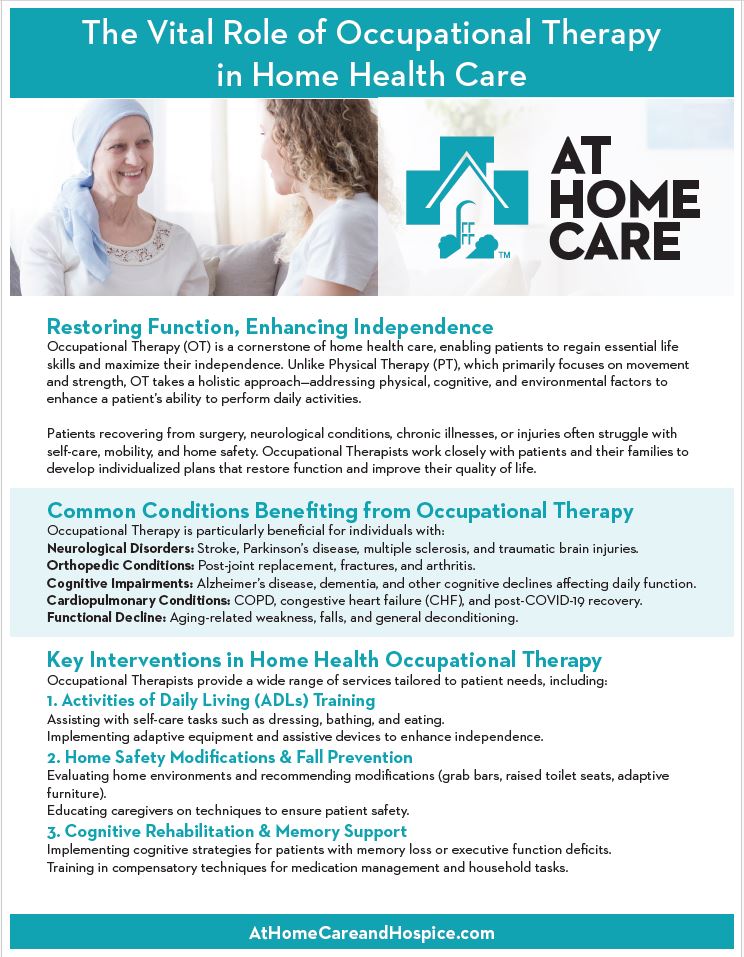Restoring Function, Enhancing Independence

Occupational Therapy (OT) is a cornerstone of home health care, enabling patients to regain essential life skills and maximize their independence. Unlike Physical Therapy (PT), which primarily focuses on movement and strength, OT takes a holistic approach – addressing physical, cognitive, and environmental factors to enhance a patient’s ability to perform daily activities.
Patients recovering from surgery, neurological conditions, chronic illnesses, or injuries often struggle with self-care, mobility, and home safety. Occupational Therapists work closely with patients and their families to develop individualized plans that restore function and improve their quality of life.
Common Conditions Benefiting from Occupational Therapy
Occupational Therapy is particularly beneficial for individuals with:
- Neurological Disorders: Stroke, Parkinson’s disease, multiple sclerosis, and traumatic brain injuries.
- Orthopedic Conditions: Post-joint replacement, fractures, and arthritis.
- Cognitive Impairments: Alzheimer’s disease, dementia, and other cognitive declines affecting daily function.
- Cardiopulmonary Conditions: COPD, congestive heart failure (CHF), and post-COVID-19 recover.
- Functional Decline: Aging-related weakness, falls, and general deconditioning.
Key Interventions in Home Health Occupational Therapy
Occupational Therapists provide a wide range of services tailored to patient needs, including:
1. Activities of Daily Living (ADLs) Training
- Assisting with self-care tasks such as dressing, bathing, and eating.
- Implementing adaptive equipment and assistive devices to enhance independence.
2. Home Safety Modifications & Fall Prevention
- Evaluating home environments and recommending modifications (grab bars, raised toilet seats, adaptive furniture).
- Educating caregivers on techniques to ensure patient safety.
3. Cognitive Rehabilitation & Memory Support
- Implementing cognitive strategies for patients with memory loss or executive function deficits.
- Training in compensatory techniques for medication management and household tasks.
4. Upper Extremity Rehabilitation
- Improving fine and gross motor skills, grip strength, and coordination for daily tasks.
- Implementing neuromuscular re-education techniques for stroke or brain injury recovery.
5. Energy Conservation & Respiratory Training
- Teaching patients with chronic conditions how to pace activities and manage fatigue.
- Educating on breath control techniques to optimize daily function.
6. Psychosocial & Emotional Well-Being
- Addressing anxiety and depression related to loss of independence.
- Implementing relaxation techniques and coping strategies for long-term conditions.
The Evidence Behind Occupational Therapy

Studies show that Occupational Therapy plays a crucial role in improving health outcomes for homebound individuals:
- Patients receiving home-based OT interventions were 55% less likely to be readmitted to the hospital within 30 days compared to those who did not receive therapy (Rogers et al., 2017).
- A systematic review found that OT interventions for fall prevention reduced fall risk by 36% in older adults living at home (Clemson et al., 2019).
- Cognitive rehabilitation led by Occupational Therapists significantly improved executive functioning and quality of life in patients with mild cognitive impairment (Tomaszewski Farias et al., 2020).
Our Commitment to Occupational Therapy & Patient Care
As a leading home health provider, we recognize the immense value that Occupational Therapists bring to patient recovery. Their expertise allows individuals to maintain independence, reduce rehospitalization risks, and navigate their daily lives with confidence.
We are honored to work alongside these dedicated professionals in delivering exceptional, patient-centered care.
Let’s Partner for Better Outcomes
If you have a patient who could benefit from Occupational Therapy, our highly skilled clinicians are ready to assist. We offer personalized care plans tailored to meet the unique needs of each patient – right in the comfort of their home.
Contact us today to refer a patient or learn more about how we can support your team in delivering exceptional care.
References
- Rogers, A. T., Bai, G., Lavin, R. A., & Anderson, G. F. (2017). Higher hospital spending on occupational therapy is associated with lower readmission rates. Medical Care Research and Review, 74(6), 668–686.
- Clemson, L., Mackenzie, L., Ballinger, C., Close, J. C. T., & Cumming, R. G. (2008). Environmental interventions to prevent falls in community-dwelling older people: A meta-analysis of randomized trials. Journal of Aging and Health, 20(8), 954–971.
- Farias, S. T., Mungas, D., & Jagust, W. (2005). Degree of discrepancy between self and other-reported everyday functioning by cognitive status: A longitudinal study. Neuropsychology, 19(4), 532–540.

Download a copy of this fact sheet here.



